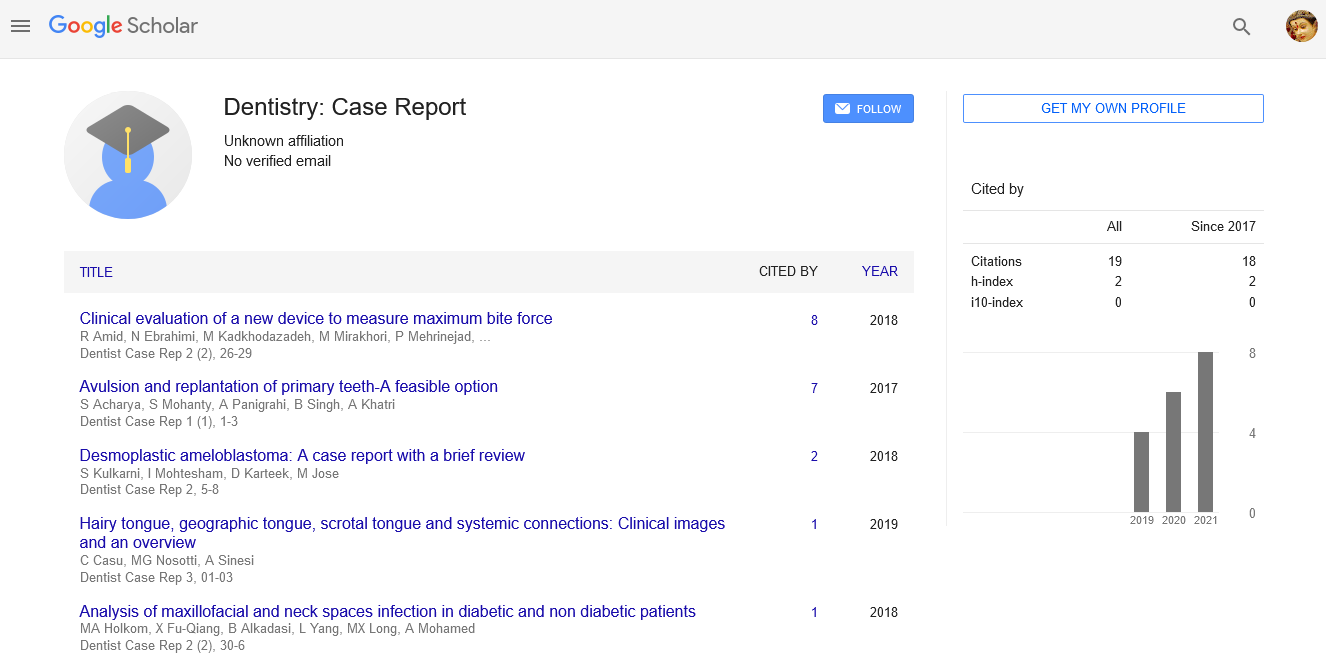Use of dental implants to replace missing teeth
Received: 04-Mar-2022, Manuscript No. puldcr-22-4808; Editor assigned: 07-Mar-2022, Pre QC No. puldcr-22-4808; Reviewed: 22-Mar-2022 QC No. puldcr-22-4808; Revised: 25-Mar-2022, Manuscript No. puldcr-22-4808; Published: 28-Mar-2022, DOI: DOI: 10.37532. puldcr-22.6.(2).1-2
This open-access article is distributed under the terms of the Creative Commons Attribution Non-Commercial License (CC BY-NC) (http://creativecommons.org/licenses/by-nc/4.0/), which permits reuse, distribution and reproduction of the article, provided that the original work is properly cited and the reuse is restricted to noncommercial purposes. For commercial reuse, contact reprints@pulsus.com
Abstract
Currently, titanium or titanium alloys are the most often utilized materials for dental implant production. The Osseo integrative potential and clinical long-term performance of moderately rough titanium implants have been established in numerous investigations. However, peri-implant infections and the titanium metal characteristics have also been described as drawbacks. Since the end of the 1960s, physicians have been interested in toothcolored ceramic implants. Initially, alumina was employed to make ceramic implants; however, alumina implants are no longer commercially accessible due to their poor biomechanical qualities.
Introduction
The uses of dental implants to replace missing teeth in partially or completely edentulous patients has become a science-based terapeutic option in dentistry. It is based on Osseo integration, which is the structural and functional stabilization of the implant in the surrounding bone tissue. Titanium or a titanium–zirconium alloy is currently the most commonly utilized material for dental implant production. The Osseo integrative capacity and clinical long-term performance of titanium implants with a somewhat rough surface topography have been validated in numerous investigations. Clinically, survival and success rates of more than 95% have been recorded following follow-up periods of up to and including ten years. However, there have been reports of problems with relation to the material qualities of the metal titanium. For example, when the grey titanium colour of the implant or abutment has become visible as a result of thin peri-implant soft tissue conditions or peri-implant crestal bone resorptions, the aesthetical long-term results are unsatisfactory. Furthermore, titanium has been linked to a number of unfavorable chemical– biological interactions with the soft and hard tissues around it. Titanium concentrations were found to be higher in the immediate area of titanium fibre felt implants and in regional lymph nodes after Titanium-Plasma-Sprayed (TPS) implants were implanted in animals. Single patient sensitizations and positive allergy tests to titanium have been documented. The clinical significance of these biological findings/disadvantages, on the other hand, is hotly debated [1]. When compared to published data on moderately rough titanium implants, zirconia dental implants of the current generation with a micro-rough surface topography exhibit equal survival and success rates. Monotypes and two-part implant systems have been studied in depth, with reported survival rates ranging from 93.3 percent to 98.2 percent for study periods ranging from one to five years. Only one recently published study found that after one and two years of follow-up, survival rates were only 87 per-cent and 86 percent, respectively. The authors of the latter study linked zirconia implant failures to "aseptic loosening", rather than periimplant infections. A multicenter study released recently looked into the identical sort of zirconia implants that were used in the current case. A total of 44 zirconia implants with a ZLA® surface topography was placed in 44 individuals with single tooth gaps. The zirconia implants had a survival and success percentage of 97.6% twelve months after they were placed. The authors also documented 0.88 mm of bone loss between implant placement and implant loading, and 0.14 mm of bone loss between implant loading and 12 months after installation [2]. Thus, zirconia implants of the most recent generation—such as those used in this case— appear to be a reliable alternative to moderately rough titanium implants from a clinical standpoint. However, more prospective trials are needed to establish the micro-roughened zirconia implants' clinical long-term durability [3 , 4]. Only the labial side of the maxilla received vertical bone augmentation prior to implant insertion. As a result, six months later, the local vertical bone volume was adequate but still impaired, particularly on the palatal side of the alveolar process. As a result of the deteriorated bone conditions, implant placement was limited. Because it is not possible to make large modifications to the implant axis using individual abutments, it is critical to install monotype implants prosthetically driven (i.e., accurate implant location and axis). However, the current instance demonstrates that monotype zirconia implants can be used even in damaged bone circumstances. All implants were implanted in a prosthetically acceptable position, parallel to one another, resulting in a functionally and aesthetically pleasing fixed prosthetic reconstruction. In this example, zirconia dental implants were used to successfully rebuild a broad edentulous area with poor local bone conditions, resulting in highly pleasing functional and esthetical outcomes. Furthermore, clinical and radiographic examinations clearly demonstrated that zirconia implants with a micro-rough surface topography could be successfully integrated with previously or concurrently performed autogenous bone augmentation treatments in the present patient.
However, more well-designed prospective clinical trials are needed to explore zirconia dental implants' clinical long-term function [5].
REFERENCES
- Branemark PI. Intra-osseous anchorage of dental prosthesis. I. Experimental studies. Scand J Plast Reconstr Surg. 1981;9:15-25.
- Roehling SK, Meng B, Cochran DL. Implant surfaces and their biological and clinical impact. Scand J Plast Reconstr Surg,
[Google Scholar] [Crossref]
- Buser D, Janner SF, Wittneben JG, et al. 10‐year survival and success rates of 511 titanium implants with a sandblasted and acid‐etched surface: a retrospective study in 303 partially edentulous patients. Clin. Implant Dent Relat Res. 2012;14(6):839-51.
- Cochran D, Oates T, Morton D, et al. Clinical field trial examining an implant with a sand‐blasted, acid‐etched surface. J Periodontol. 2007;78(6):974-82.
- Roccuzzo M, Bonino L, Dalmasso P, et al. Long‐term results of a three arms prospective cohort study on implants in periodontally compromised patients: 10‐year data around sandblasted and acid‐etched (SLA) surface. Clin Oral Implants Res. 2014;25(10):1105-12.





